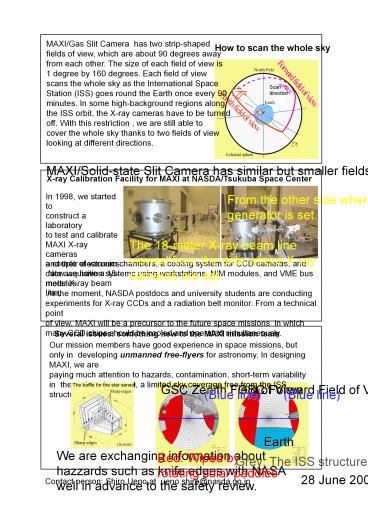How to scan the whole sky - PowerPoint PPT Presentation
1 / 1
Title:
How to scan the whole sky
Description:
How to scan the whole sky. MAXI/Gas Slit Camera has two strip-shaped ... a couple of vacuum chambers, a cooling system for CCD cameras, and data ... – PowerPoint PPT presentation
Number of Views:65
Avg rating:3.0/5.0
Title: How to scan the whole sky
1
MAXI/Gas Slit Camera has two strip-shaped
fields of view, which are about 90 degrees away
from each other. The size of each field of view
is 1 degree by 160 degrees. Each field of view
scans the whole sky as the International
Space Station (ISS) goes round the Earth once
every 90 minutes. In some high-background
regions along the ISS orbit, the X-ray cameras
have to be turned off. With this restriction ,
we are still able to cover the whole sky thanks
to two fields of view looking at different
directions. MAXI/Solid-state Slit Camera has
similar but smaller fields of view.
How to scan the whole sky
Scan direction
X-ray Calibration Facility for MAXI at
NASDA/Tsukuba Space Center
In 1998, we started to construct a laboratory
to test and calibrate MAXI X-ray cameras and
their electronics. Now we have a 18- meter X-ray
beam line,
From the other side where an X-ray generator is
set.
The 18-meter X-ray beam line viewed from the side
where X-ray cameras are set.
a couple of vacuum chambers, a cooling system for
CCD cameras, and data acquisition systems using
workstations, NIM modules, and VME bus modules.
At the moment, NASDA postdocs and university
students are conducting experiments for X-ray
CCDs and a radiation belt monitor. From a
technical point of view, MAXI will be a precursor
to the future space missions in which many CCD
chips should be cooled and operated
simultaneously.
Several issues something new to the MAXI mission
team
Our mission members have good experience in space
missions, but only in developing unmanned
free-flyers for astronomy. In designing MAXI, we
are paying much attention to hazards,
contamination, short-term variability in thermal
environment, a limited sky coverage free from the
ISS structure.
GSC Zenith Field of View
GSC Forward Field of View
The baffle for the star sensor
(Blue line)
(Blue line)
Earth
We are exchanging information about hazzards such
as knife edges with NASA well in advance to the
safety review.
Red Wiped by rotating solar paddles
Grey The ISS structure
Contact person Shiro Ueno at ueno.shiro_at_nasda.go
.jp 28 June 2000































